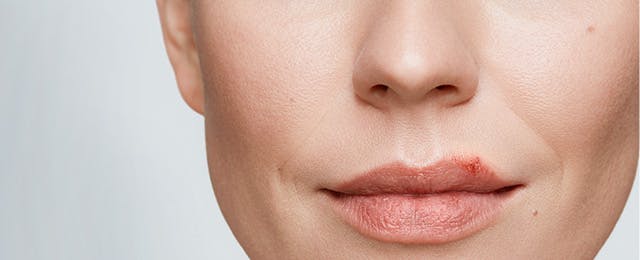
Cold Sore vs. Pimple
If you’ve ever wondered whether or not the pesky blemish on or around your lips is a cold sore or a pimple, you’re definitely not alone. Knowing if a blemish is a cold sore versus a pimple is a common question many people have and it can sometimes be tricky to know for sure just by looking at the area. Let’s unpack some of the possible ways to distinguish a cold sore versus a pimple on the lip.
Identifying a Cold Sore
Cold sores can appear as small clusters or patches of fluid-filled blisters. These blisters on or around your lips will likely burst at some point and leave a scab that can last for many days and take anywhere from one to two weeks to heal completely.i In addition to what they look like, there are some common symptoms to keep an eye out for. If you have a cold sore, you may experience the following:
- Itching: if you feel a burning or tingling sensation on or around the lips a day before you notice what appears to be a blister or a blemish, you may have a cold sore.
- Oozing blisters: When small blisters merge and burst, people notice sores that later ooze and create a crust.
- Fever, muscle aches, headache, sore throat, swollen lymph nodes: if it’s your first time experiencing a cold sore outbreak, you may experience any of these symptoms beforehand or during.ii
Identifying a Lip Pimple
It’s safe to assume that some of the more serious symptoms such as fever and muscle aches will likely not accompany a pimple on or near the lips. There are at times, however, similar visible characteristics between cold sores and pimples that leave people wondering what they have. There are several types of acne you can experience.
- White heads: this form of acne looks like small, white, or flesh-colored bumps with a white center and red halo surrounding it.
- Black heads: this type of raised bump is usually very small and has a black, or dark-colored, spot that is usually a bit raised. The surrounding skin of a blackhead is usually normal.iii
- Inflammatory acne: this type of acne usually causes lesions that are swollen and warm to the touch. Mild forms of this acne, called papules, are raised, tender, and the skin around is swollen and red. These tend to have no visible center like black heads or white heads. Pustules, also known as pimples, tend to be larger, tender, and have a circular center with colored pus.iv
To recap, the kinds of symptoms experienced with a pimple or a cold sore tend to look different. With a cold sore, keep an eye out for sensations such as itching and burning, while a pimple can sometimes be tender or painful to the touch. In either case, if you’re unsure how to go about treating the affected area, be sure to consult with your doctor for potential treatment options. In either case, do not pop or pick at either a cold sore or a pimple as this can make the condition worse.
For more topics related to cold sores, how to treat them, and other topics such as these, be sure to visit the Abreva site.
SOURCES
i-ii. Cold Sore Symptoms & Causes. MayoClinic. https://www.mayoclinic.org/diseases-conditions/cold-sore/symptoms-causes/syc-20371017. Referenced text is boxed in red in sourcing document. Accessed 12/17/2020.
iii-iv. What type of acne do I have? Medical News Today. https://www.medicalnewstoday.com/articles/322322#inflammatory-acne-types. Referenced text is boxed in red in sourcing document. Accessed 12/17/2020.
By clicking the link(s) above, you will be taken to an external website that is independently operated and not managed by Haleon. Haleon assumes no responsibility for the content on the website. If you do not wish to leave this website, do not click on the links above.




